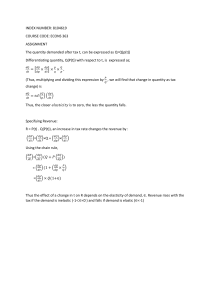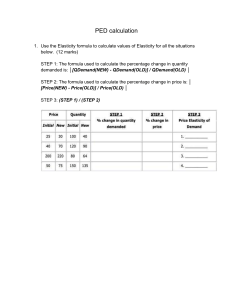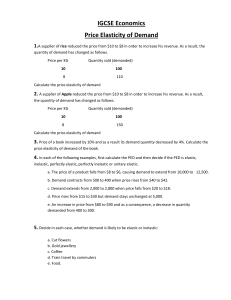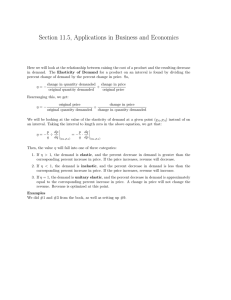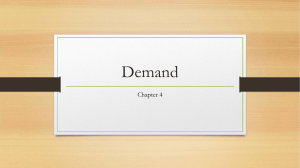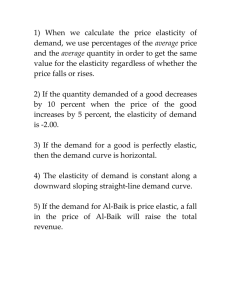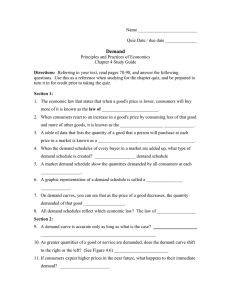Price Elasticity PowerPoint Speaking Notes
advertisement
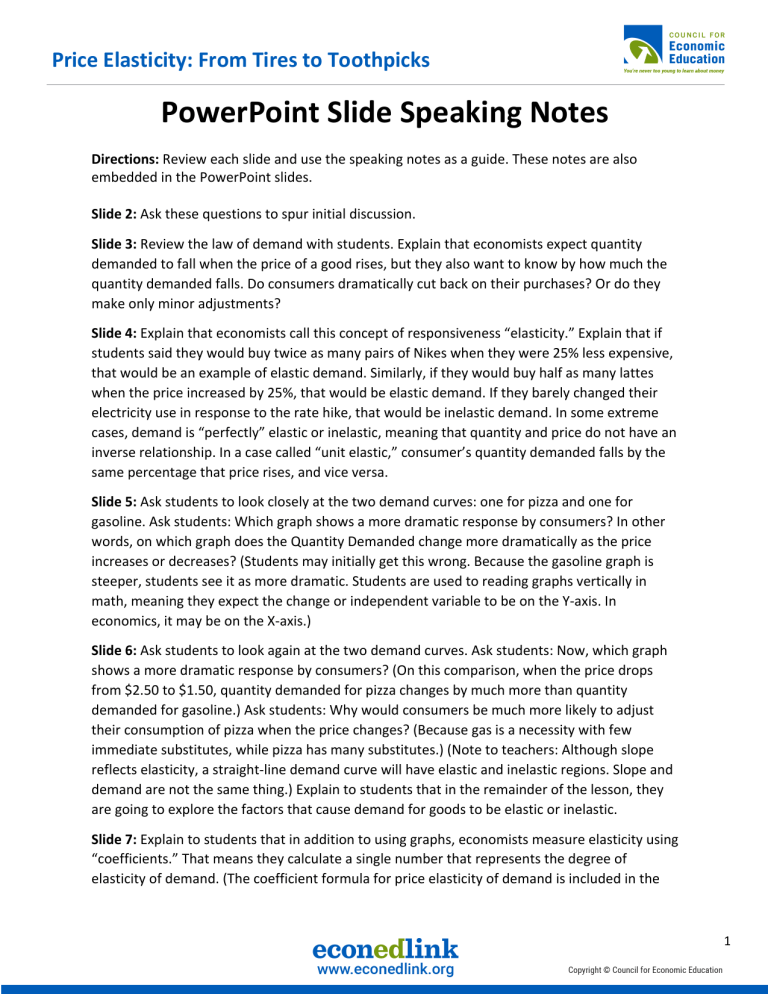
Price Elasticity: From Tires to Toothpicks PowerPoint Slide Speaking Notes Directions: Review each slide and use the speaking notes as a guide. These notes are also embedded in the PowerPoint slides. Slide 2: Ask these questions to spur initial discussion. Slide 3: Review the law of demand with students. Explain that economists expect quantity demanded to fall when the price of a good rises, but they also want to know by how much the quantity demanded falls. Do consumers dramatically cut back on their purchases? Or do they make only minor adjustments? Slide 4: Explain that economists call this concept of responsiveness “elasticity.” Explain that if students said they would buy twice as many pairs of Nikes when they were 25% less expensive, that would be an example of elastic demand. Similarly, if they would buy half as many lattes when the price increased by 25%, that would be elastic demand. If they barely changed their electricity use in response to the rate hike, that would be inelastic demand. In some extreme cases, demand is “perfectly” elastic or inelastic, meaning that quantity and price do not have an inverse relationship. In a case called “unit elastic,” consumer’s quantity demanded falls by the same percentage that price rises, and vice versa. Slide 5: Ask students to look closely at the two demand curves: one for pizza and one for gasoline. Ask students: Which graph shows a more dramatic response by consumers? In other words, on which graph does the Quantity Demanded change more dramatically as the price increases or decreases? (Students may initially get this wrong. Because the gasoline graph is steeper, students see it as more dramatic. Students are used to reading graphs vertically in math, meaning they expect the change or independent variable to be on the Y-axis. In economics, it may be on the X-axis.) Slide 6: Ask students to look again at the two demand curves. Ask students: Now, which graph shows a more dramatic response by consumers? (On this comparison, when the price drops from $2.50 to $1.50, quantity demanded for pizza changes by much more than quantity demanded for gasoline.) Ask students: Why would consumers be much more likely to adjust their consumption of pizza when the price changes? (Because gas is a necessity with few immediate substitutes, while pizza has many substitutes.) (Note to teachers: Although slope reflects elasticity, a straight-line demand curve will have elastic and inelastic regions. Slope and demand are not the same thing.) Explain to students that in the remainder of the lesson, they are going to explore the factors that cause demand for goods to be elastic or inelastic. Slide 7: Explain to students that in addition to using graphs, economists measure elasticity using “coefficients.” That means they calculate a single number that represents the degree of elasticity of demand. (The coefficient formula for price elasticity of demand is included in the 1 Price Elasticity: From Tires to Toothpicks extension activity and should be taught to IB/AP students.) The coefficient represents the percentage change in quantity demanded divided by the percentage change in price, so if the change in quantity demanded is disproportionately greater than the change in price, the coefficient will be greater than 1, and demand is elastic. If the two changes are proportional, the coefficient will equal 1, and demand is unit elastic. If the change in quantity demanded is disproportionately smaller than the percentage change in price, the coefficient will be less than 1, and demand is inelastic. Explain that a coefficient less than 1 does not mean a negative number. The coefficient will be a decimal between 0 and 1. (Elasticity of demand is measured as an absolute value, so there will not be negative coefficients.) Ask students to record the information on Slide 7 for use in the next activity. Slide 8: Activity Instructions 2
